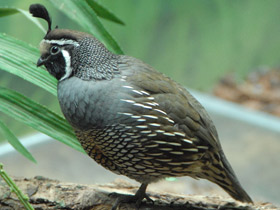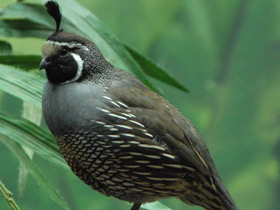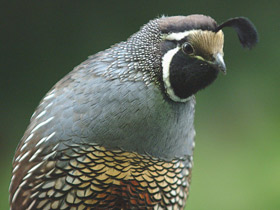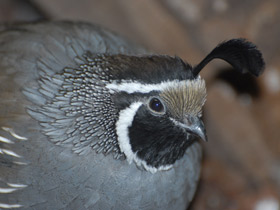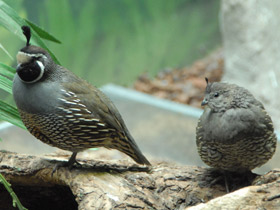The California quail (or California valley quail) Callipepla californica
California quail видео
The California quail were originally found mainly in the south-western United States. The California quail is the state bird of California, but it has been introduced into other areas including British Columbia, Hawaii, Chile, New Zealand, and to Norfolk Island and King Island in Australia. It inhabits diverse landscapes at altitudes of up to 2,450 m above sea level. California quail prefer living in open woodlands, bushy foothills, valleys with streams, savannahs, evergreen forests, deserts, and agricultural lands. These small quail measuring 23-25 cm in length, often live in shrubby areas, with the height of shrubs ranging between 1 and 7 metres. California quail are sedentary birds that are mostly active in the daylight, spending nighttimes in trees. Califormnia quail forage on the ground, often scratching at the soil. They can sometimes be seen feeding at the sides of the roads. Their diet consists mainly of seeds and leaves, but they also eat some berries and small insects; for example, Toyon berries are a common food source. They also like peas, vetches, and other plants of bean family, which grow in vicinity of human settlements. If startled, these birds explode into a short rapid flight, called "flushing". Given a choice, they will normally escape on foot.
The California quail has a curving crest or plume, made of four to six feathers, that droops forward: these feathers are black in males and brown in females; the flanks are brown with white streaks. The California quail are highly sociable birds that often gather in small flocks known as "coveys"; the coveys may consist of 10 to 200–300 individuals. One of these quail’s daily communal activities is a dust bath. A group of quail will select an area where the ground has been newly turned or is soft, and using their underbellies, will burrow downward into the soil some 2 to 6 cm. They then wriggle about in the indentations they have created, flapping their wings and ruffling their feathers, causing dust to rise in the air. They seem to prefer sunny places for dust bathing.
By springtime, the flocks split up into pairs. Males start displaying in early March; they fan their wing and tail feathers and strut in front of the females, producing loud calls. They utter the agonistic "squill" and often interrupt their social mate's "chicago" call with a "squill", a possible form of antiphonal calling. The nest is a shallow scrape built on the ground beneath a shrub or other cover and lined with vegetation. The female usually lays 10 to 17 dark brown, speckled eggs and incubates them for 22-23 days, while the male stays close, protecting the female and her eggs from predators. In case of the female’s death, the male may replace her on the nest and continue incubating eggs.
Once hatched, the young associate with both adults. Often, families group together, into multifamily "communal broods" which include at least two females, multiple males, and many offspring. Males associated with families are not always the genetic fathers. In good years, females will lay more than one clutch, leaving the hatched young with the associated male and laying a new clutch, often with a different male. Young California quail grow fast and reach the size of an adult bird at the age of 80–105 days.

















